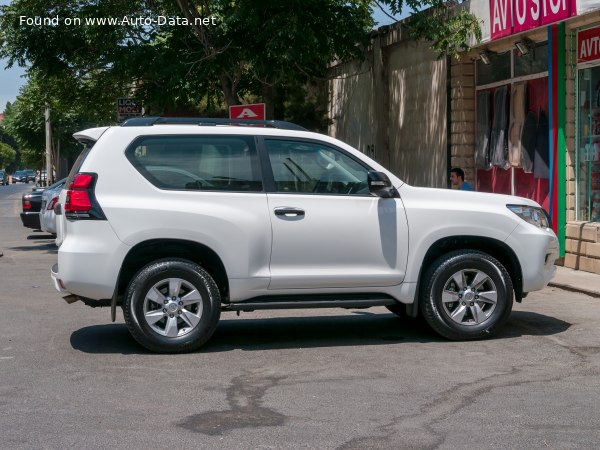Everything you need to know about specifications and performance - Toyota Land Cruiser Prado 2020 - 2.8 D-4D (204 Hp) 4WD

Overview:
What is the engine capacity of a Toyota Land Cruiser Prado 2020?
The engine capacity of the Toyota Land Cruiser Prado 2020 is 2755 cm.
Toyota Land Cruiser Prado 2020 How many horsepower?
The engine power of the Toyota Land Cruiser Prado 2020 is 204 Hp @ 3000 rpm..
What is the Toyota Land Cruiser Prado 2020 engine?
Toyota Land Cruiser Prado 2020 engine is 1GD-FTV. (Click to see other cars using the same engine)
How much gasoline does a Toyota Land Cruiser Prado 2020 consume?
The Toyota Land Cruiser Prado 2020 consumes 7.5-7.7 liters of gasoline per 100 km
General:
Brand: Toyota
Model: Land Cruiser Prado
Generation: Land Cruiser Prado (J150, facelift 2017) 3-door
Modification (Engine): 2.8 D-4D (204 Hp) 4WD
Start of production: September, 2020
End of production: October, 2023
Powertrain Architecture: Internal Combustion Engine
Body type:Sports Utility Vehicle (SUV)
Seats: 5
Doors: 3
Engine:
Engine systems: Start & Stop System
Power: 204 hp @ 3000 rpm.
Power per litre: 74 hp/l
Torque: 420 nm @ 1400-3400 rpm.
Engine Model/Code:1GD-FTV
Engine displacement: 2755 cm
Number of cylinders: 4
Engine configuration: Inline
Number of valves per cylinder: 4
Fuel injection system: Diesel Commonrail
Engine aspiration: Turbocharger, Intercooler
Valvetrain: DOHC
Engine oil capacity: 7.7 l
Coolant: 10.3 l
Engine layout: Front, Longitudinal
Cylinder Bore: 92 mm
Piston Stroke: 103.6 mm
Compression ratio: 15.6
Performance:
Fuel Type: Diesel
Fuel consumption (economy) - urban: 8.6-8.8 l/100 km
Fuel consumption (economy) - extra urban: 6.9-7.1 l/100 km
Fuel consumption (economy) - urban (NEDC, WLTP equivalent): 8.6-8.8 l/100 km
Fuel consumption (economy) - extra urban (NEDC, WLTP equivalent): 6.9-7.1 l/100 km
Fuel consumption (economy) - combined (NEDC, WLTP equivalent): 7.5-7.7 l/100 km
Fuel consumption (economy) - combined: 7.5-7.7 l/100 km
Emission standard: Euro 6d-ISC-Fcm
Acceleration 0 - 100 km/h: 11.2 sec
Acceleration 0 - 62 mph: 11.2 sec
Maximum speed: 175 km/h
Weight-to-power ratio: 9.8 kg/Hp, 102.5 Hp/tonne
Weight-to-torque ratio: 4.7 kg/Nm, 211.1 Nm/tonne
Acceleration 0 - 60 mph: 10.6 sec
Space:
Kerb Weight: 1990 kg
Max. weight: 2600 kg
Max. roof load: 80 kg
Max load: 610 kg
Trunk (boot) space - maximum: 1434 l
Trunk (boot) space - minimum: 381 l
Permitted trailer load with brakes (12%): 3000 kg
Fuel tank capacity: 87 l
Permitted trailer load without brakes: 750 kg
Permitted towbar download: 120 kg
Permitted trailer load with brakes (8%): 3500 kg
dimensions:
Ramp-over (brakeover) angle: 25°
Wading depth: 700 mm
Length: 4395 mm
Width: 1885 mm
Height: 1830 mm
wheelbase: 2450 mm
Front track: 1585 mm
Rear (Back) track: 1585 mm
Front overhang: 975 mm
Rear overhang: 970 mm
Ride height (ground clearance): 205 mm
Minimum turning circle (turning diameter): 10.4 m
Approach angle: 32°
Departure angle: 26°
Climb angle: 42°
Powertrain, Suspension and Brakes:
Drivetrain Architecture: The Internal combustion Engine (ICE) drives permanently the four wheels of the vehicle.
Drive wheel: All wheel drive (4x4)
Number of gears and type of gearbox: 6 gears, manual transmission
Front brakes: Ventilated discs
Rear brakes: Ventilated discs
Assisting systems: ABS (Anti-lock braking system)
Steering type: Steering rack and pinion
Power steering: Electric Steering
Tires size: 245/70 R17; 265/65 R17; 265/55 R19
Wheel rims size: 17; 19
Front suspension: Double wishbone, Transverse stabilizer
Rear suspension: Rigid axle suspension, Coil spring, Air Suspension - Optional
See also

Other generation.
Its production began in 2000 until 2002

Same engine. (1GD-FTV).
Its production began in 2017 until 2020
Write a comment